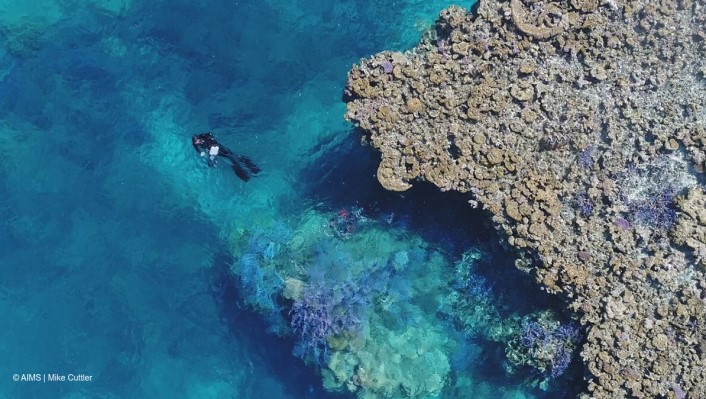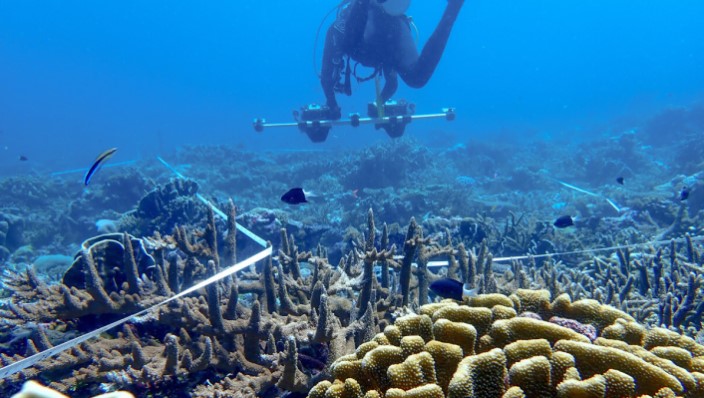To date, climate change and coral bleaching has affected WA oceanic reefs differently. Some have suffered recurrent bleaching, while others are in good shape compared to many coral reef systems around the world under current levels of climate change. But the future outlook for all is not so rosy.
As our oceans heat, these biodiverse oceanic reefs will be more susceptible to coral loss and degradation because of their isolation and lower larval exchange following coral reproduction.
So what can be done to help these reefs be more resilient?
Reducing global greenhouse gas emissions is key, but good management and marine science are vital as well.
This is why AIMS scientists are taking a deep dive into Mermaid and Ashmore reefs off the north west shelf as part of the Building Resilience in Australia's Iconic Offshore Reefs project, in support of Parks Australia's Ocean Discovery and Restoration Program.

Coral reef scientist Dr James Gilmour, who leads the project for AIMS, said far less is known about the condition of north west Australia's coral reefs and their exposure to threats than we know about the Great Barrier Reef.
"Reefs like Ashmore and Mermaid have contrasting patterns of bleaching, and the best way to manage their future condition remains a complicated puzzle we are still trying to solve," he said.
"They are difficult to study because of their remoteness - Mermaid Reef is a 12 hour steam from the town of Broome in far north WA, while Ashmore Reef is two days from Darwin in the NT.
"There is still so much about them we are trying to understand. We need to collect data about the natural processes of impact, recovery and adaptation, such as how habitats and currents influence community composition, exposure to bleaching or recruitment rates within these reefs.
"Building this knowledge and using it to develop a modelling framework to guide management actions by Parks Australia will help to reduce local pressures and inform whether the application of interventions will improve reef condition.
"And this could bring benefits to other oceanic coral reefs in Australian waters and beyond as we apply the modelling we develop to their management."
For this project, Dr Gilmour and a multidisciplinary team of AIMS scientists have already visited Mermaid and Ashmore reefs to undertake a number of activities that are helping to unpick the unknowns.
Coral monitoring sites and photogrammetry plots have been set up to record changes in coral communities, including growth and survival, and genetic samples have been collected to help scientists learn about processes of recovery and adaptation to heat stress on these reefs.

The scientists are also surveying sea floor habitats and fish communities, and installing oceanographic and acoustic instruments so they can understand how diverse these isolated reefs are and the critical connections among different organisms that help to sustain the reefs.
They will be heading to both reefs again in October to continue collecting this data, and once more in April 2025.
"Later this year, we'll also be bringing together managers from Parks and scientists from across disciplines at AIMS to discuss how our science can most effectively inform management strategies," said Dr Gilmour.
"By collecting all this data on habitat distribution, community change, oceanography and genetics, we will populate a model specific to oceanic reefs. Combining this with guidance from Parks Australia's marine park managers will help us to combine our science with a pragmatic approach to bolstering resilience on Australia's oceanic reefs.
"Together we will explore strategies that consider climate pressures, traditional management approaches and novel interventions, pinpointing the approaches that are most likely to make a difference. For example, we want to know which habitats will be most suitable for coral recruitment and survival."
The Building Resilience in Australia's Iconic Offshore Reefs project is co-funded by AIMS and the Australian Government through the Ocean Discovery and Restoration Program.
Banner image: Fish in coral at Ashmore Reef, by Molly Mae Baker






